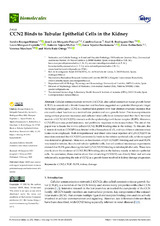Mostrar el registro sencillo del ítem
CCN2 Binds to Tubular Epithelial Cells in the Kidney
| dc.contributor.author | Rayego-Mateos, Sandra | |
| dc.contributor.author | Morgado-Pascual, José Luis | |
| dc.contributor.author | Lavoz, Carolina | |
| dc.contributor.author | Rodrigues-Díez, Raúl R. | |
| dc.contributor.author | Márquez-Expósito, Laura | |
| dc.contributor.author | Tejera-Muñoz, Antonio | |
| dc.contributor.author | Tejedor-Santamaría, Lucía | |
| dc.contributor.author | Rubio-Soto, Irene | |
| dc.contributor.author | Marchant, Vanessa | |
| dc.contributor.author | Ruiz-Ortega, Marta | |
| dc.date.accessioned | 2022-02-04T13:26:37Z | |
| dc.date.available | 2022-02-04T13:26:37Z | |
| dc.date.issued | 2022 | |
| dc.identifier.uri | http://hdl.handle.net/10396/22416 | |
| dc.description.abstract | Cellular communication network-2 (CCN2), also called connective tissue growth factor (CTGF), is considered a fibrotic biomarker and has been suggested as a potential therapeutic target for kidney pathologies. CCN2 is a matricellular protein with four distinct structural modules that can exert a dual function as a matricellular protein and as a growth factor. Previous experiments using surface plasmon resonance and cultured renal cells have demonstrated that the C-terminal module of CCN2 (CCN2(IV)) interacts with the epidermal growth factor receptor (EGFR). Moreover, CCN2(IV) activates proinflammatory and profibrotic responses in the mouse kidney. The aim of this paper was to locate the in vivo cellular CCN2/EGFR binding sites in the kidney. To this aim, the C-terminal module CCN2(IV) was labeled with a fluorophore (Cy5), and two different administration routes were employed. Both intraperitoneal and direct intra-renal injection of Cy5-CCN2(IV) in mice demonstrated that CCN2(IV) preferentially binds to the tubular epithelial cells, while no signal was detected in glomeruli. Moreover, co-localization of Cy5-CCN2(IV) binding and activated EGFR was found in tubules. In cultured tubular epithelial cells, live-cell confocal microscopy experiments showed that EGFR gene silencing blocked Cy5-CCN2(IV) binding to tubuloepithelial cells. These data clearly show the existence of CCN2/EGFR binding sites in the kidney, mainly in tubular epithelial cells. In conclusion, these studies show that circulating CCN2(IV) can directly bind and activate tubular cells, supporting the role of CCN2 as a growth factor involved in kidney damage progression. | es_ES |
| dc.format.mimetype | application/pdf | es_ES |
| dc.language.iso | eng | es_ES |
| dc.publisher | MDPI | es_ES |
| dc.rights | https://creativecommons.org/licenses/by/4.0/ | es_ES |
| dc.source | Biomolecules 12(2), 252 (2022) | es_ES |
| dc.subject | CCN2 | es_ES |
| dc.subject | CTGF | es_ES |
| dc.subject | EGFR | es_ES |
| dc.subject | Kidney damage | es_ES |
| dc.title | CCN2 Binds to Tubular Epithelial Cells in the Kidney | es_ES |
| dc.type | info:eu-repo/semantics/article | es_ES |
| dc.relation.publisherversion | https://doi.org/10.3390/biom12020252 | es_ES |
| dc.relation.projectID | Instituto de Salud Carlos III.PI17/00119 | es_ES |
| dc.relation.projectID | Instituto de Salud Carlos III. PI20/00140 | es_ES |
| dc.relation.projectID | Instituto de Salud Carlos III. DTS20/00083 | es_ES |
| dc.relation.projectID | Instituto de Salud Carlos III. CD20/00042 | es_ES |
| dc.relation.projectID | Gobierno de España. EIN2019-103294 | es_ES |
| dc.relation.projectID | Gobierno de España. FJC2019-042028-I | es_ES |
| dc.relation.projectID | Gobierno de España. IJC2018-035187-I | es_ES |
| dc.relation.projectID | Instituto de Salud Carlos III. RD21/0005 | es_ES |
| dc.relation.projectID | Instituto de Salud Carlos III. RD16/0009 | es_ES |
| dc.rights.accessRights | info:eu-repo/semantics/openAccess | es_ES |

